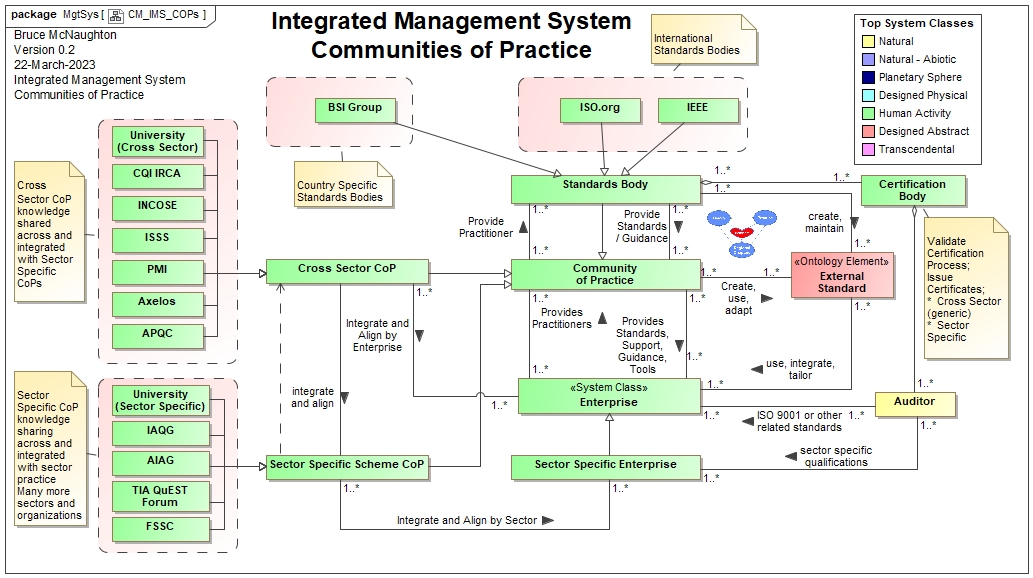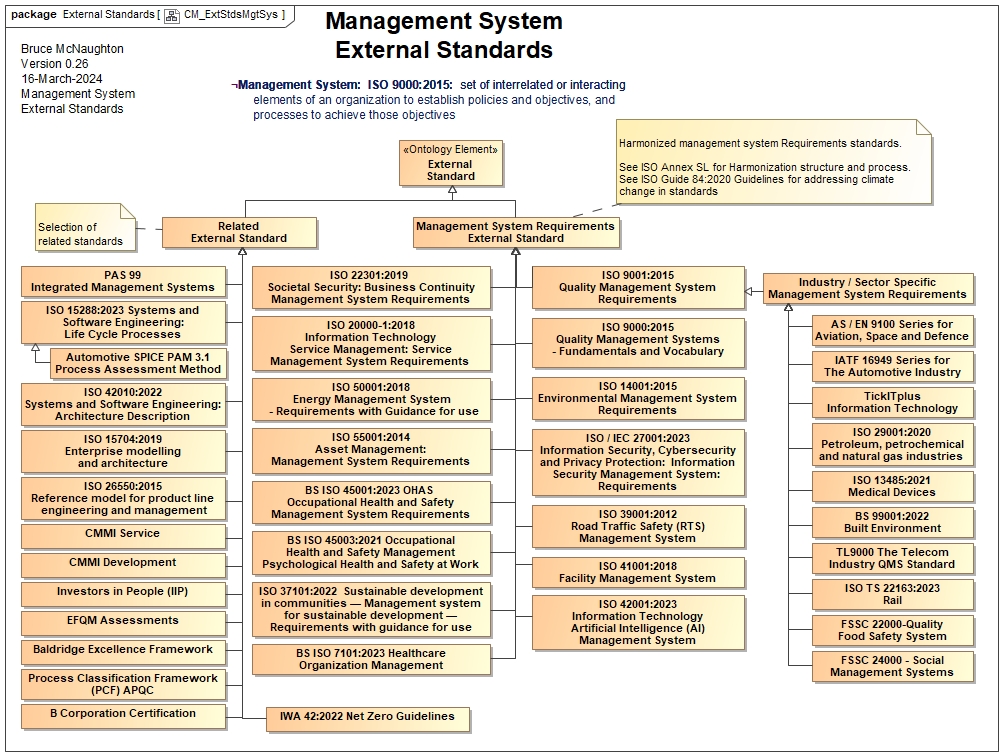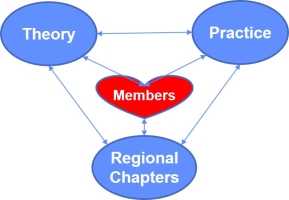Integrated Management System
The Integrated Management System is the system-of-interest for this System Description.
The concept of a Management System builds on the ISO 9001:2015 standard for Quality Management System - Requirements.
- Management System: ISO 9000:2015: set of interrelated or interacting elements of an organization to establish policies and objectives, and processes to achieve those objectives.
An Integrated Management System is a type of organization that has realized a set of organizational capabilities that meets one or more external management system standards. This Integrated Management System may also integrate one or more Best Practice methods and / or external regulations along with the necessary technology assets to support the organizational capabilities.
This document identifies the key elements found in an Integrated Management System that meets the various management system standards. This document also focuses on the approach to embed a management system into an Enterprise to realize the organizational capabilities.
This document uses the Enterprise Systems identified in the Enterprise as a System of Systems (SoS) System Description as the context for the Integrated Management System.
PDF: System Description: Enterprise as a System of Systems (SoS),
PDF: System Description: Integrated Management System,
Integrated Management Systems build on the knowledge bases of a number of communities of practice. These knowledge bases provide the following benefits:
- Agreed standards as a starting point for implementation
- Best practice knowledge for developing processes and capabilities within an organization.
- Common language used across organizations or sectors
- Establishing a set of tools and technology that supports Integrated Management Systems.
- Development of competencies in people that can be shared across organizations and provide specific skills and development for career progression.
- The multi-dimensional operating model provides a way to see how the Integrated Management System can scale from small organizations to multi-national organizations.
Communities of Practice
Communities of Practice are Human Activity Systems that create theory and share practice across a set of organizations. The typical elements of a Community of Practice (CoP) is shown below:
The members are considered to be key to both creating the knowledge base (Theory) from their experience and sharing the knowledge (Practice) in organizations where this is needed.
The Community of Practice consists of a core set of knowledge (Theory) that is established and managed through practitioner teams (members). The knowledge provides the basis for sharing across many organizations (Regional Chapters).
The next diagram highlights the various types of Community of Practice (CoP) that are available to help organizations within an Enterprise create an Integrated Management System.

Standards Bodies
Standards bodies provide the focus for establishing both international and country speific standards to enable consistent and coherent approaches across various organizations. Some of these organizations have been highlighted in the diagram.
Cross Sector Communities of Practice
There are a number of organizations (universities and organisations) that collaborate to establish a knowledge base around various topics used in organizations. These topics are used in any type of organization or enterprise and ensure consistent language, methods, and tool development (interoperability). Some examples of this type of Community of Practice (CoP) are shown in the diagram.
Sector Specific Communities of Practice
There are a number of organizations (universities and organizations) that collaborate to establish knolwedge base around various sector specific topics. This also build on the standards created in the standards bodies (e.g. ISO 9001) and tailor them to a specific industry sector using specific language and practice for the sector. A few of the sector specific Community of Practice (CoP) have been identified in the diagram (e.g. Aerospace, Automotive, Telecommunications).
Certification Bodies
Certification bodies provide audit capabilities against specific standards. These standards can be cross sector or sector specific. The auditing process and auditor qualification will be compatible with the standards that are being used for the Certificate.
Integrated Management Systems draw on a number of Community of Practice (CoP) to establish the capabilities of the Management System.
Management System Requirements
The following diagram highlights the current set of external management system and best practice standards related to management system requirements: These have been developed by various Community of Practice (CoP) organizations.

The management system standards have been derived from ISO 9001:2015 to form a harmonized set of standards based upon common definitions and requirements using Annex SL. In addition to the common definitions, each standard contains requirements for a unique set of capabilities that realize the specific focus of the standard (e.g. environment, business continuity, information security, health and safety, etc). See Wikipedia: Annex SL and ISO MSS and Annex SL
In addition to harmonized management system standards, there is a group of Industry and Sector specific standards that tailor or provide additional management system requirements. These are listed as a set of standards providing more detail to ISO 9001 (e.g. AS / EN 9100, IATF 16949 or TIA QuEST Forum (TL9000)).
Some Sector Specific Assessment Standards are a type of ISO 15288 and are based upon life cycle processes. The Automotive SPICE PAM is an example.
The Food Infrastructure Service has supporting international standard sector schemes. The FSSC 22000 is a key sector scheme used across the whole Food Value System. This certification can also be combined with ISO 9001:2015. This forms the basis for an Integrated Management System within an Enterprise. See also ISO 22000:2018 for information about Food Safety Management Systems definitions and requirements
The management system is the System-of-Interest produced by addressing the management system requirements. In this way, establishing and maintaining a management system that meets these management system requirements can use the full ISO 15288 life cycle.
The implementation / realization of the resulting Integrated Management System also relates very closely to improving organizational maturity and culture.
The Integrated Management System is established using the following system descriptions from the Enterprise as a System of Systems (SoS):
- Organization
- Capability
- Person (as living system)
- Technology System (use and integration of designed physical system)
- Process
NOTE: Technology System life cycles are covered in separate life cycles.
The Integrated Management System is described as a set of capabilities needed to create an organization that meets the requirements of the above standards.
PDF: System Description: Integrated Management System,
The organization is architected using the following Architecture Description Framework:
-
Link to prototype Enterprise (SoS) Architecture Description Framework
The resulting Architecture Description of the Enterprise that includes the required capabilities will meet the requirements of the selected standards.
The organization is created or improved using the life cycle derived from ISO 15288:2015 using the Architecture based change approach.
The Enterprise Transformation and Change PDF contains the Enterprise Transformation and Change Concepts.
